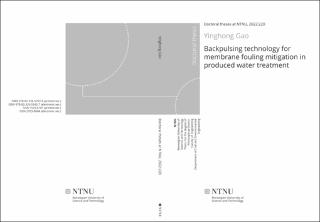| dc.contributor.advisor | Østerhus, Stein Wold | |
| dc.contributor.advisor | Wang, Zhiwei | |
| dc.contributor.author | Gao, Yinghong | |
| dc.date.accessioned | 2022-07-29T11:39:40Z | |
| dc.date.available | 2022-07-29T11:39:40Z | |
| dc.date.issued | 2022 | |
| dc.identifier.isbn | 978-82-326-5542-7 | |
| dc.identifier.issn | 2703-8084 | |
| dc.identifier.uri | https://hdl.handle.net/11250/3009172 | |
| dc.description.abstract | Produced water from oil and gas industry poses an immense threat to the environment due to its substantial volume and complicated composition. Membrane filtrations especially with ceramic membranes can effectively remove emulsified oil and suspended solids and meet the requirements for discharge or reinjection. However, membrane fouling is severe in the treatment of produced water and is the largest obstacle to the wide application of membrane technology. Physical cleaning can mitigate membrane fouling, reduce the frequency of chemical cleaning, thus prolong membrane lifetime, and reduce operational costs. Backpulsing is a promising physical cleaning method, which is induced by periodically reversing the transmembrane pressure (TMP) for a very short duration (typically less than 1 s). It has a transient effect that can effectively mitigate membrane fouling.
In this doctoral work, backpulsing technology applied in microfiltration (MF) and ultrafiltration (UF) processes was reviewed while the experimental rig was built up in the lab. After the setup was finished, commissioned, and optimized, various experiments were carried out to investigate the significance of backpulsing parameters and their interactions on backpulsing efficiency, membrane fouling situations in the filtration of different types of produced water, and fouling mitigation by backpulsing compared with backwashing.
The backpulsing review addresses the fundamentals of backpulsing, applications of backpulsing in different fields and results of pilot- and commercial-scale operations. Factors affecting backpulsing efficiency are illustrated, including feed properties, membrane properties and operating parameters. Mathematical models of backpulsing are overviewed, which could predict membrane productivity or provide a perspective to evaluate backpulsing performance in fouling mitigation. Finally, the existing challenges and outlook are discussed.
Experiments using with a 2^3 full factorial design were carried out to investigate the effect of backpulsing parameters (amplitude, duration and frequency) and their interactions on membrane performance. Results based on Al2O3 membranes show that backpulsing was efficient to mitigate membrane fouling. However, the cleaning efficiency varied between different backpulsing conditions. Amplitude was the most crucial variable for fouling removal and final specific flux, while frequency was the most significant one for membrane net yield. Further experiments were conducted to find the optimum backpulsing frequency at a sufficient amplitude (0.5 bar) and a moderate duration (0.6 s). Ceramic membranes with three types of selective layers (TiO2, Al2O3 and ZrO2) were tested. For the same type of feed water and under the same filtration conditions, the optimal backpulsing frequencies of the three membranes were in a range of 11 – 15 s. A backpulsing frequency of 12 s was selected for the later backpulsing experiments. Later, ten types of produced water, including two based on treated real produced water, were used in the crossflow microfiltration with the three ceramic membranes mentioned above. Pure fouling experiments were carried out without any cleaning. Fouling behavior due to different compositions of produced water was investigated. Moreover, four out of the ten types of produced water were selected for longer experiments to compare the efficiency of fouling mitigation by backpulsing and backwashing. Backpulsing was in general much better than backwashing in terms of the net yield during the 12 h filtrations. Nevertheless, the trend of flux recovery after each backpulse/backwash was not always backpulsing better than backwashing. The flux recovery was depended on the fouling situation in each specific case. ZrO2 membrane showed the best performance in the three membranes, which was in accordance with that ZrO2 membrane had the narrowest membrane pore size distribution. | en_US |
| dc.language.iso | eng | en_US |
| dc.publisher | NTNU | en_US |
| dc.relation.ispartofseries | Doctoral theses at NTNU;2022:220 | |
| dc.relation.haspart | Paper 1: Gao, Yinghong; Qin, Jie; Wang, Zhiwei; Østerhus, Stein Wold. Backpulsing technology applied in MF and UF processes for membrane fouling mitigation: A review. Journal of Membrane Science 2019 ;Volum 587:117136. s. 1-20Gao, Yinghong; Qin, Jie; Wang, Zhiwei; Østerhus, Stein Wold. Backpulsing technology applied in MF and UF processes for membrane fouling mitigation: A review. Journal of Membrane Science 2019 ;Volum 587:117136. s. 1-20 https://doi.org/10.1016/j.memsci.2019.05.060 This is an open access article under the CC BY-NC-ND license | en_US |
| dc.relation.haspart | Paper 2: Gao, Yinghong; Zhang, Yeqing; Dudek, Marcin; Qin, Jie; Øye, Gisle; Østerhus, Stein Wold. A multivariate study of backpulsing for membrane fouling mitigation in produced water treatment. Journal of Environmental Chemical Engineering 2020 https://doi.org/10.1016/j.jece.Volume 9, Issue 2, April 2021, 104839 .This is an open access article under the CC BY-NC-ND license104839 | en_US |
| dc.relation.haspart | Paper 3:
Gao, Yinghong; Abdelhamed, Yasser K.; Dudek, Marcin; Wan, Junli; Xiaoyang, Guo; Øye, Gisli; Østerhus, Stein Wold.
Application of ceramic membranes for produced water treatment. Part I: Effect of feed compositions on membrane fouling | en_US |
| dc.relation.haspart | Paper 4:
Gao, Yinghong; Abdelhamed, Yasser K.; Dudek, Marcin; Wan, Junli; Xiaoyang, Guo; Øye, Gisli; Østerhus, Stein Wold.
Application of ceramic membranes for produced water treatment. Part II: Comparison of backpulsing and backwashing for membrane fouling mitigation | en_US |
| dc.title | Backpulsing technology for membrane fouling mitigation in produced water treatment | en_US |
| dc.type | Doctoral thesis | en_US |
| dc.subject.nsi | VDP::Technology: 500::Environmental engineering: 610 | en_US |

